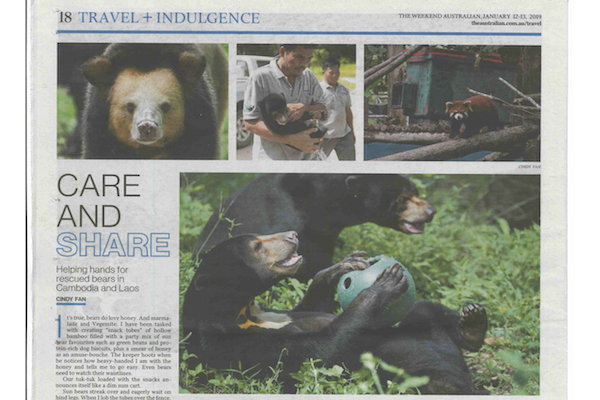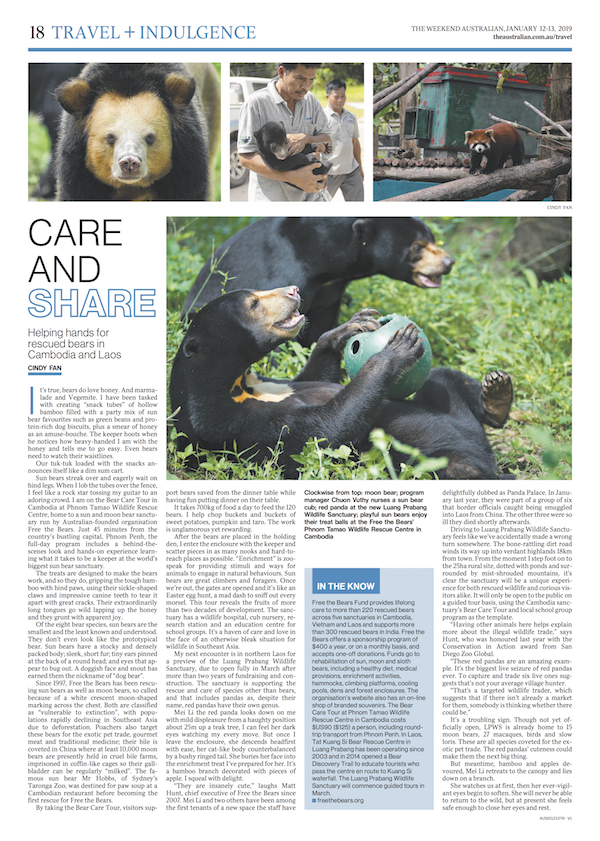The bear necessities
The Australian | Saturday, January 12th, 2019

Care and Share: Helping hands for rescued bears in Cambodia and Laos
By Cindy Fan
It’s true, bears do love honey. And marmalade and Vegemite. I have been tasked with creating “snack tubes” of hollow bamboo filled with a party mix of sun bear favourites such as green beans and protein-rich dog biscuits, plus a smear of honey as an amuse-bouche. The keeper hoots when he notices how heavy-handed I am with the honey and tells me to go easy. Even bears need to watch their waistlines.
Our tuk-tuk loaded with the snacks announces itself like a dim sum cart.
Sun bears streak over and eagerly wait on hind legs. When I lob the tubes over the fence, I feel like a rock star tossing my guitar to an adoring crowd. I am on the Bear Care Tour in Cambodia at Phnom Tamao Wildlife Rescue Centre, home to a sun and moon bear sanctuary run by Australian-founded organisation Free the Bears. Just 45 minutes from the country’s bustling capital, Phnom Penh, the full-day program includes a behind-the-scenes look and hands-on experience learning what it takes to be a keeper at the world’s biggest sun bear sanctuary.
The treats are designed to make the bears work, and so they do, gripping the tough bamboo with hind paws, using their sickle-shaped claws and impressive canine teeth to tear it apart with great cracks. Their extraordinarily long tongues go wild lapping up the honey and they grunt with apparent joy.
Of the eight bear species, sun bears are the smallest and the least known and understood. They don’t even look like the prototypical bear. Sun bears have a stocky and densely packed body; sleek, short fur; tiny ears pinned at the back of a round head; and eyes that appear to bug out. A doggish face and snout has earned them the nickname of “dog bear”.
Since 1997, Free the Bears has been rescuing sun bears as well as moon bears, so called because of a white crescent moon-shaped marking across the chest. Both are classified as “vulnerable to extinction”, with populations rapidly declining in Southeast Asia due to deforestation. Poachers also target these bears for the exotic pet trade, gourmet meat and traditional medicine; their bile is coveted in China where at least 10,000 moon bears are presently held in cruel bile farms, imprisoned in coffin-like cages so their gallbladder can be regularly “milked”. The famous sun bear Mr Hobbs, of Sydney’s Taronga Zoo, was destined for paw soup at a Cambodian restaurant before becoming the first rescue for Free the Bears.
By taking the Bear Care Tour, visitors support bears saved from the dinner table while having fun putting dinner on their table.
It takes 700kg of food a day to feed the 120 bears. I help chop buckets and buckets of sweet potatoes, pumpkin and taro. The work is unglamorous yet rewarding.
After the bears are placed in the holding den, I enter the enclosure with the keeper and scatter pieces in as many nooks and hard-to-reach places as possible. “Enrichment” is zoo-speak for providing stimuli and ways for animals to engage in natural behaviours. Sun bears are great climbers and foragers. Once we’re out, the gates are opened and it’s like an Easter egg hunt, a mad dash to sniff out every morsel. This tour reveals the fruits of more than two decades of development. The sanctuary has a wildlife hospital, cub nursery, research station and an education centre for school groups. It’s a haven of care and love in the face of an otherwise bleak situation for wildlife in Southeast Asia.
My next encounter is in northern Laos for a preview of the Luang Prabang Wildlife Sanctuary, due to open fully in March after more than two years of fundraising and construction. The sanctuary is supporting the rescue and care of species other than bears, and that includes pandas as, despite their name, red pandas have their own genus.
Mei Li the red panda looks down on me with mild displeasure from a haughty position about 25m up a teak tree, I can feel her dark eyes watching my every move. But once I leave the enclosure, she descends headfirst with ease, her cat-like body counterbalanced by a bushy ringed tail. She buries her face into the enrichment treat I’ve prepared for her. It’s a bamboo branch decorated with pieces of apple. I squeal with delight.
“They are insanely cute,” laughs Matt Hunt, chief executive of Free the Bears since 2007. Mei Li and two others have been among the first tenants of a new space the staff have delightfully dubbed as Panda Palace. In January last year, they were part of a group of six that border officials caught being smuggled into Laos from China. The other three were so ill they died shortly afterwards.
Driving to Luang Prabang Wildlife Sanctuary feels like we’ve accidentally made a wrong turn somewhere. The bone-rattling dirt road winds its way up into verdant highlands 18km from town. From the moment I step foot on to the 25ha rural site, dotted with ponds and surrounded by mist-shrouded mountains, it’s clear the sanctuary will be a unique experience for both rescued wildlife and curious visitors alike. It will only be open to the public on a guided tour basis, using the Cambodia sanctuary’s Bear Care Tour and local school group program as the template.
“Having other animals here helps explain more about the illegal wildlife trade,” says Hunt, who was honoured last year with the Conservation in Action award from San Diego Zoo Global.
“These red pandas are an amazing example. It’s the biggest live seizure of red pandas ever. To capture and trade six live ones suggests that’s not your average village hunter.
“That’s a targeted wildlife trader, which suggests that if there isn’t already a market for them, somebody is thinking whether there could be.”
It’s a troubling sign. Though not yet officially open, LPWS is already home to 15 moon bears, 27 macaques, birds and slow loris. These are all species coveted for the exotic pet trade. The red pandas’ cuteness could make them the next big thing.
But meantime, bamboo and apples devoured, Mei Li retreats to the canopy and lies down on a branch.
She watches us at first, then her ever-vigilant eyes begin to soften. She will never be able to return to the wild, but at present she feels safe enough to close her eyes and rest.
In The Know
Free the Bears Fund provides lifelong care to more than 220 rescued bears across five sanctuaries in Cambodia, Vietnam and Laos and supports more than 300 rescued bears in India. Free the Bears offers a sponsorship program of $400 a year, or on a monthly basis, and accepts one-off donations. Funds go to rehabilitation of sun, moon and sloth bears, including a healthy diet, medical provisions, enrichment activities, hammocks, climbing platforms, cooling pools, dens and forest enclosures. The organisation’s website also has an on-line shop of branded souvenirs. The Bear Care Tour at Phnom Tamao Wildlife Rescue Centre in Cambodia costs $US90 ($125) a person, including round-trip transport from Phnom Penh. In Laos, Tat Kuang Si Bear Rescue Centre in Luang Prabang has been operating since 2003 and in 2014 opened a Bear Discovery Trail to educate tourists who pass the centre en route to Kuang Si waterfall. The Luang Prabang Wildlife Sanctuary will commence guided tours in March.
This story was published in The Weekend Australian, Travel + Indulgence, January 12-13, 2019. Digital access may only be for subscribers only.
